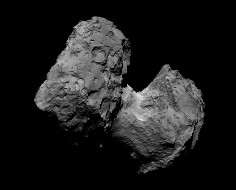
European Space Agency
Comet 67P/Churyumov-Gerasimenko appears to have split into two segments that briefly orbited each other and then slowly merged into a new configuration.
In a new study about periodic comets (those that orbit the Sun in fewer than 200 years), scientists now suspect that comets regularly split in two and reunite later in their life, a repeating process fundamental to comet evolution.
Postdoctoral fellow Masatoshi Hirabayashi (Purdue University), working with Daniel Sheeres (University of Colorado-Boulder) and others, studied the nucleus of comet 67P/Churyumov-Gerasimenko (67P), which has been under close scrutiny by the European Space Agency’s Rosetta spacecraft since 2014. They found two straight cracks, each a few hundred meters long and separated from each other by 750 m, on the narrow neck that connect the comet’s two large lobes.
The team found that jets of gas and dust shooting into space cause the nucleus to spin faster and faster, until internal stress forms large cracks on the surface and eventually splits the comet. Once that happens, the separated segments orbit each other for some time, ultimately going through a slow merger that results in a new shape.
“The head and body aren’t going to be able to escape from each other,” said Sheeres. “They will begin orbiting each other, and in weeks, days or even hours they will come together again during a slow collision, creating a new comet nucleus configuration.” This pattern could go on for the comet’s lifetime.
Causing Spin
Previous studies by the University of Bern suggest the cracks on the surface might have been created by tidal forces that arose during a brush with Jupiter, but that would have required a close Jupiter flyby within a narrow range of distances. Instead, Hirabayashi’s team modeled what would happen as the spin rate increased from one rotation every 12 hours to every 7 to 9 hours. This faster spin caused more stress and the formation of cracks in the same locations as those found on 67P.
“Our spin analysis predicted exactly where these cracks would form,” said Scheeres in a press release. “We now have a new understanding of how some comets may evolve over time.”
Scheeres also said there are several factors that can cause a comet nucleus to spin faster. Gravitational torquing by the Sun or Jupiter might be involved. The spin can be affected by icy compounds like ammonia and carbon dioxide, which are present on the surfaces of comets, go from being frozen to escaping from the surface in a gas — a process called sublimation.
Bi-lobed Comets
Other periodic comets — among them 1P/Halley — are known to have a double-lobed shape. Of the seven comets astronomers have seen at high resolution, five — including 67P and 1P/Halley — are bi-lobed.
So could this be a common characteristic among periodic comets? “The conclusion that the other comets are necessarily bi-lobate is not so obvious as with 67P,” said Uwe Keller (Max Planck Institute for Astronomy). He says other comets that undergo sublimation also have elongated shapes, but that not all elongated comets need to be of bi-lobate origin.
The analysis by Hirbayashi’s team appears in the June 1st issue of Nature.
 1
1









Comments
Bob
June 14, 2016 at 12:59 am
Ana...
I enjoy reading your articles -- well researched -- well written -- excellent use of images. Thank you for sharing your education and talent.
...Bob
You must be logged in to post a comment.
You must be logged in to post a comment.